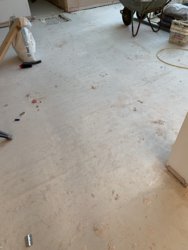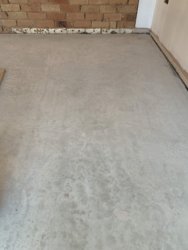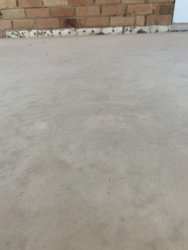GrayD
TF
Hi all,
I'm new to the forum but have read many posts over the past year as I have created and tiled a wet room and also created and tiled a bathroom in my house that we are renovating. I've also tiled our utility room too. Thanks for all the tips & tricks I learned!
So, I'm ok with tiling walls and simple floors (they get better each time!) but I'm no expert by any stretch. I have all the relevant tools, etc but haven't ever tiled on a new screed floor.
So, here's the background: (bear with me!)
We had a wet UFH system (ProWarm) laid under a 45mm flow screed and the 45m2 floor has been down now since 29th March - nearly 7 weeks. UFH hasn't been turned on. The screed company that laid the floor had to change their material provider last minute because the other one messed up their schedule or something. I'm 90% sure the screed is not anhydrite but I am not 100% sure... There looks like there could be something that looks 'like' calcification on the surface but it's not all over and really only in a few patches here and there. I didn't order anhydrite but I can't be sure what's been laid. Here's the reason why...
The floor company who laid it down created a 4-5mm difference between two areas (thermal break between heated and non-heated floor areas) by not setting it out properly I guess but I only saw this after I trimmed the Celotex thermal break to floor level between the two areas.
They are refusing to deal with the issue so we have fell out now because to me they should sand back the higher area as they knew I was tiling the whole floor across the thermal break. It's only a small area that's too high - 3m2 max so no big deal for them. The upshot is that they aren't coming back to me on whether the floor is or is not anhydrite.
So, I am going to treat it as if it is anhydrite just to be 100% sure we don't get a failure. I'm also going belt & braces on it because I don't want any issues at all.
What I am thinking is as follows, please do tell me if I am wrong, have chosen the wrong product(s) or there's anything I have missed or just not thought about - thanks!
Porcelain tiles on the floor:
1. prep the floor by getting rid of any points, etc and then sweep & hoover it
2. prime the floor a couple of times with Mapei Eco Prim Grip
3. lay down a Durabase CI membrane across the whole area - wall to wall and over thermal break -
4. use Mapei Kerquick adhesive (or better to use Kerakoll Biogel maybe?)
5. use Mapei Ultra Colour Plus grout
Seems so simple when I have written now (!) but I want to be certain I am going about this in the right way.
Thanks in advance for any pointers, appreciated.
Ps. any clues on how to stick down the Durbase would be appreciated too - Kerquick with Latext Plus? Not sure.
I'm new to the forum but have read many posts over the past year as I have created and tiled a wet room and also created and tiled a bathroom in my house that we are renovating. I've also tiled our utility room too. Thanks for all the tips & tricks I learned!
So, I'm ok with tiling walls and simple floors (they get better each time!) but I'm no expert by any stretch. I have all the relevant tools, etc but haven't ever tiled on a new screed floor.
So, here's the background: (bear with me!)
We had a wet UFH system (ProWarm) laid under a 45mm flow screed and the 45m2 floor has been down now since 29th March - nearly 7 weeks. UFH hasn't been turned on. The screed company that laid the floor had to change their material provider last minute because the other one messed up their schedule or something. I'm 90% sure the screed is not anhydrite but I am not 100% sure... There looks like there could be something that looks 'like' calcification on the surface but it's not all over and really only in a few patches here and there. I didn't order anhydrite but I can't be sure what's been laid. Here's the reason why...
The floor company who laid it down created a 4-5mm difference between two areas (thermal break between heated and non-heated floor areas) by not setting it out properly I guess but I only saw this after I trimmed the Celotex thermal break to floor level between the two areas.
They are refusing to deal with the issue so we have fell out now because to me they should sand back the higher area as they knew I was tiling the whole floor across the thermal break. It's only a small area that's too high - 3m2 max so no big deal for them. The upshot is that they aren't coming back to me on whether the floor is or is not anhydrite.
So, I am going to treat it as if it is anhydrite just to be 100% sure we don't get a failure. I'm also going belt & braces on it because I don't want any issues at all.
What I am thinking is as follows, please do tell me if I am wrong, have chosen the wrong product(s) or there's anything I have missed or just not thought about - thanks!
Porcelain tiles on the floor:
1. prep the floor by getting rid of any points, etc and then sweep & hoover it
2. prime the floor a couple of times with Mapei Eco Prim Grip
3. lay down a Durabase CI membrane across the whole area - wall to wall and over thermal break -
4. use Mapei Kerquick adhesive (or better to use Kerakoll Biogel maybe?)
5. use Mapei Ultra Colour Plus grout
Seems so simple when I have written now (!) but I want to be certain I am going about this in the right way.
Thanks in advance for any pointers, appreciated.
Ps. any clues on how to stick down the Durbase would be appreciated too - Kerquick with Latext Plus? Not sure.



